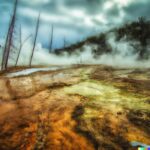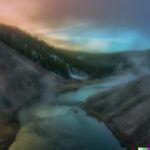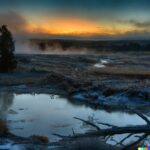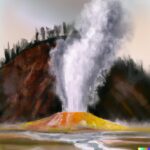Short Answer:
Yellowstone National Park is most famous for its iconic geyser, Old Faithful. Old Faithful is renowned for its predictability, erupting approximately every 90 minutes, shooting hot water and steam high into the air. Its consistent eruptions and stunning displays attract millions of visitors each year, making it a symbol of the park’s natural wonders.
Long Answer:
Hey there, fellow adventurers! Have you ever dreamt of standing amidst a landscape straight out of a fantasy novel, where geysers shoot high into the sky like nature’s own fireworks? Well, let me tell you about a place where this dream becomes a spectacular reality – Yellowstone National Park! And at the heart of this geothermal wonderland lies a celebrity among geysers, a true rockstar of the steamy stage – none other than the legendary Old Faithful.
Picture this: You’re strolling through a land of bubbling mud pots and colorful hot springs, the earth rumbling beneath your feet as if it’s trying to whisper its secrets. Suddenly, you hear a distant roar, like a dragon awakening from its slumber. Excited murmurs ripple through the crowd as everyone knows what’s about to happen. You quicken your pace, anticipation building with each step. And then, there it is – Old Faithful, standing tall and proud against the backdrop of Yellowstone’s wild beauty, ready to put on a show like no other.
In this article, we explain what Yellowstone is, and talk more about its most famous geyser – Old Faithful.
What Is Yellowstone National Park?
Yellowstone National Park, located primarily in Wyoming, is a renowned national park famous for its diverse geothermal features, breathtaking landscapes, and rich geological history.
Its most famous geothermal feature, Old Faithful, delights visitors with its predictable eruptions of hot water and steam, showcasing the park’s volcanic origins.
The park’s vast wilderness also serves as a habitat for a variety of wildlife, including grizzly bears, wolves, and the iconic American bison.
Yellowstone’s commitment to conservation is evident in its ongoing efforts to protect and preserve its natural resources, ensuring that future generations can continue to enjoy the park’s beauty and wonder.
What Are Geysers?
Geysers are hydrothermal features that exhibit periodic eruptions of hot water and steam due to underground geothermal activity, making them fascinating natural phenomena shaped by volcanic processes.
What Are The Most Famous Geysers In Yellowstone National Park?
Yellowstone National Park is home to some of the most famous geysers in the world, with Old Faithful standing out as an iconic geyser known for its spectacular water spout eruptions.
#1 – Old Faithful
Old Faithful is perhaps the most iconic geyser in Yellowstone National Park, renowned for its predictably timed and impressive eruptions that draw visitors from around the globe.
(Above – This is a video I filmed of Old Faithful)
Its predictable eruption intervals, which occur approximately every 90 minutes, have fascinated scientists and travelers alike for generations. The geyser’s towering plumes of scalding water and steam, reaching heights of up to 180 feet, have cemented its global fame. Tourists eagerly gather around the perimeter, cameras at the ready, eagerly awaiting the next awe-inspiring display of nature’s power. The rhythmic cycle of bubbling and spouting serves as a mesmerizing reminder of the Earth’s geothermal activity and the beauty of Yellowstone’s geysers.
#2 – Steamboat Geyser
Steamboat Geyser is another remarkable geothermal feature in Yellowstone known for its sporadic but impressive eruptions, fueled by the park’s geothermal hotspot and underlying seismic activities.
Unlike other geysers in Yellowstone, Steamboat Geyser showcases the tallest eruptions, shooting water up to 300 feet into the air. Its infrequent eruptions make them all the more spectacular, as pressure builds underground for weeks or even years before releasing in a powerful display. Scientists closely monitor Steamboat Geyser due to its link to seismic activities, with some eruptions believed to be triggered by shifts in the Earth’s crust. This geyser’s unique behavior provides crucial insights into the complex interactions between geothermal energy and geological forces within Yellowstone National Park’s dynamic landscape.
#3 – Grand Geyser
Grand Geyser, with its intricate geologic history and picturesque thermal pool, exemplifies the complex geothermal ecosystem present in Yellowstone, showcasing the park’s underground reservoirs and geologic structures.
The thermal pools at Grand Geyser contribute to its uniqueness, offering a mesmerizing display of vibrant colors and bubbling hot springs. These pools, rich in minerals and heat, sustain a diverse array of microorganisms and algae that thrive in the extreme conditions. Beneath the surface, the underlying reservoirs feed the geothermal features, regulating the timing and intensity of the eruptions that Grand Geyser is renowned for. This intricate network of natural processes creates a dynamic and constantly evolving environment that continues to shape the landscape of Yellowstone National Park.
#4 – Castle Geyser
Castle Geyser, nestled within a captivating geothermal basin, impresses visitors with its distinctive cone shape and silica deposits formed by continuous geothermal activity, showcasing the power and beauty of Yellowstone’s hydrothermal features.
The location of the geyser adds to its allure, as it stands in a prime position within Yellowstone National Park’s Upper Geyser Basin. The intricate silica formations that adorn Castle Geyser’s cone are a result of the mineral-rich waters that flow from deep beneath the earth’s surface. This geyser’s connection to geothermal power is not just limited to its visual spectacle; it plays a vital role in understanding the geothermal processes that shape the park’s landscape.
#5 – Giant Geyser
Giant Geyser, a testament to nature’s geologic wonders, showcases the raw power of geothermal exploration with its towering eruptions that reach near-boiling temperatures, emanating from the park’s thermal vents.
These remarkable displays draw researchers and visitors alike to witness the immense forces beneath the Earth’s surface, providing invaluable insights into the inner workings of our planet.
As one of the key attractions within the geothermal field, Giant Geyser serves as a prime example of the intricate geological processes at play, offering a unique opportunity to observe the dynamic relationship between heat, water, and rock formations.
The geyser’s proximity to thermal vents underscores its significance in the larger context of geothermal energy production and research, making it a focal point for studying the Earth’s natural energy resources.
What Makes Old Faithful The Most Famous Geyser?
Old Faithful’s widespread fame as the most iconic geyser in Yellowstone stems from its predictably timed eruptions, captivating visitors with the mesmerizing display of geothermal power set against the backdrop of Yellowstone’s unique seismic activities.
Predictable Eruptions
Old Faithful’s fame is anchored in its predictability, with eruptions occurring at regular intervals due to the precise balance of temperature, pressure, and underground vent structure.
The predictability of Old Faithful’s eruptions can be attributed to the underlying geothermal dynamics of the geyser. As subterranean water reaches boiling temperatures, it generates steam that builds up pressure within the vent. This pressure then forces the water to periodically burst out, resulting in the iconic eruptions. The specific dimensions and characteristics of the vent play a crucial role in regulating the release of the steam and water mixture. These combined factors create a harmonious orchestration that has mesmerized visitors for generations.
Impressive Height and Duration
The towering height and prolonged duration of Old Faithful’s eruptions are a testament to the immense heat source beneath Yellowstone and the geyser’s deep-seated connection to the park’s geologic history.
These mesmerizing displays can reach heights of over 100 feet, sending powerful streams of water and steam into the air, captivating visitors with their sheer power and beauty.
The eruptions, which can last anywhere from 1.5 to 5 minutes, showcase the remarkable underground plumbing system that channels the scalding hot water from deep within the earth to create this natural spectacle.
Understanding the thermal energy powering these eruptions adds a layer of awe to the historical narrative surrounding Old Faithful, illustrating the ongoing geothermal dynamics at play.
Accessibility
Old Faithful’s accessibility via well-constructed boardwalks and proximity to the historic Old Faithful Inn ensures that visitors can marvel at this geothermal wonder up close, experiencing its eruptions and evolving steam phases in a safe and immersive environment.
As visitors stroll along the boardwalks, they are treated to a front-row seat of Old Faithful’s majestic eruptions, where boiling water shoots skyward on a regular schedule. The nearby Old Faithful Inn offers a charming retreat after a day of exploring, with its iconic rustic architecture drawing inspiration from the natural beauty surrounding it. Situated within the breathtaking geothermal basin of Yellowstone National Park, Old Faithful’s location provides an unparalleled opportunity for visitors to witness the raw power of nature firsthand.
Historical Significance
Old Faithful’s historical significance extends beyond its eruptions, reflecting the deep-rooted geologic structures, diverse geothermal ecosystems, and volcanic soils that define Yellowstone’s unique natural heritage.
These eruptions are not merely geological phenomena; their regularity and predictability symbolize the stability and endurance of the natural world. This iconic geyser has captivated visitors for generations, offering a glimpse into the dynamic forces at play beneath the Earth’s surface. The volcanic activity that powers Old Faithful is a testament to the ever-changing landscape of Yellowstone and the ongoing processes that shape our planet’s surface. From the intricate network of geothermal features to the rich biodiversity supported by the park’s thermal waters, Old Faithful stands as a beacon of the park’s geological and ecological significance.
What Are The Other Geysers To Visit In Yellowstone National Park?
Apart from Old Faithful, Yellowstone National Park offers a plethora of geysers and hot springs that make it a top tourist destination, showcasing the captivating beauty of thermal springs and the geologic processes shaping the park’s diverse landscapes.
Riverside Geyser
Riverside Geyser, nestled near a hydrothermal reservoir, showcases the dynamic forces of geothermal power while raising awareness about the delicate balance between natural wonders and environmental impact in Yellowstone.
The proximity of Riverside Geyser to the hydrothermal reservoir allows visitors to witness firsthand the steam vents, bubbling pools, and colorful mineral deposits that are characteristic of geothermal activity. This geyser serves as a living example of the interconnectedness of geology and ecology, highlighting how the unique habitat surrounding the geyser supports a variety of plant and animal species adapted to the extreme conditions.
The sight of water shooting up to 75 feet in the air against a backdrop of lush greenery truly emphasizes the resilience and beauty of nature in the midst of such powerful geological processes.
Daisy Geyser
Daisy Geyser captivates visitors with its rhythmic eruptions, showcasing the intricate interplay of geothermal activity, thermal vents, and the technological advancements that enable a deeper understanding of Yellowstone’s geothermal landscape.
The eruption patterns of Daisy Geyser are not only mesmerizing but also hold valuable insights into the underground volcanic processes that power these natural spectacles.
In addition to its eruptions, Daisy Geyser’s connection to the broader geothermal activities in the region highlights the interconnectedness of Yellowstone’s thermal features, forming a complex network of underground channels and reservoirs.
Technology plays a crucial role in studying and preserving these geothermal wonders, allowing researchers to monitor changes, detect potential threats, and implement conservation measures to safeguard Yellowstone’s natural treasures.
Sawmill Geyser
Sawmill Geyser stands as a geological marvel in Yellowstone, offering insights into the park’s ancient history, the passage of geologic time, and the formation of mineral deposits that enrich the park’s diverse landscapes.
The eruption patterns of Sawmill Geyser provide a window into Yellowstone’s volcanic past, showcasing the dynamic processes that have shaped the region over millions of years. As water and minerals interact within the geyser, they create colorful terraces and unique rock formations that epitomize the park’s geological diversity. The geyser’s activity also underscores the ongoing geologic processes that continue to mold Yellowstone’s landscape, highlighting the interconnected relationship between geological forces and the creation of natural wonders.
Beehive Geyser
Beehive Geyser showcases the abundance of geothermal resources beneath Yellowstone, with subterranean heat fueling its majestic eruptions and shaping the distinctive geologic features that define the park’s landscape.
As one of Yellowstone’s most famous geysers, Beehive Geyser offers a prime example of the park’s dynamic geological activity. Its towering eruptions demonstrate the powerful interaction between the underground heat sources and the surface environment. The surrounding geologic features, such as colorful hot springs, terraces, and fumaroles, further underscore the diverse and unique geothermal landscape of Yellowstone. Through these natural wonders, visitors can witness firsthand the incredible forces of nature at work and gain a deeper appreciation for the geological heritage preserved within the park.
Great Fountain Geyser
Great Fountain Geyser exemplifies the dynamic nature of Yellowstone’s geothermal landscape, offering glimpses into the earth’s crust and the intricate hydrothermal processes that shape the park’s stunning geologic formations.
This fascinating geyser, known for its predictable and powerful eruptions, stands as a testament to the relentless forces at work beneath the Earth’s surface. The interactions of superheated water, steam, and various minerals within the geyser’s complex underground plumbing system create a spectacle that mesmerizes visitors.
As the geyser erupts in a dramatic display, reaching heights that can exceed 100 feet, it highlights the incredible energy stored within Yellowstone’s volcanic system. This unique thermal feature contributes significantly to the park’s ever-changing landscape, showcasing the ongoing geological processes that continuously shape this dynamic environment.
Frequently Asked Questions
What is the Most Famous Yellowstone Geyser?
The most famous geyser in Yellowstone National Park is definitely Old Faithful.
Why is Old Faithful the Most Famous Yellowstone Geyser?
Old Faithful is the most famous geyser in Yellowstone because of its frequent and predictable eruptions, as well as its iconic appearance.
How Often Does Old Faithful Erupt?
Old Faithful erupts approximately every 90 minutes, with eruptions lasting 1.5 to 5 minutes.
When Was Old Faithful First Discovered?
Old Faithful was first discovered in 1870 during the Washburn Expedition, and was named for its reliable and consistent eruptions.
What Makes Old Faithful Different from Other Geysers in Yellowstone?
Old Faithful is unique because of its consistent and predictable eruptions, as well as its large size and beautiful cone shape.
Can Visitors See Old Faithful Erupt?
Yes, visitors can witness the eruptions of Old Faithful from designated viewing areas within the Upper Geyser Basin in Yellowstone National Park.
Last Updated on February 18, 2024 by Jon Waraas – Originally Posted: February 11, 2024

I’m Jon Waraas, and I’ve been navigating the online world since 2006. By day, I’m the proud owner of some eCommerce gems, and by night, I’m the voice behind the adventures on Waraas.Com.
My heart, however, belongs to the wild beauty of Yellowstone National Park. I’ve got a collection of websites dedicated to sharing the wonders of this natural masterpiece. Oh, and did I mention? I’m currently building my own cabin inside the ghost town of Gilmore, Idaho – a cabin with tales to tell!
When I’m not immersed in the digital realm, you’ll find me lacing up my boots for a good hike or setting up camp under the star-studded sky.




